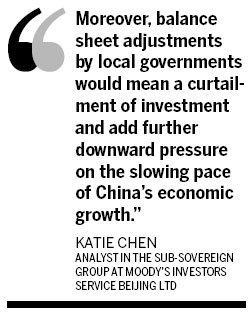Regulator tells banks to focus on risk, credit structure
Updated: 2013-08-02 07:24
By Wu Yiyao in Shanghai (China Daily)
|
|||||||||||
The China Banking Regulatory Commission on Wednesday urged financial institutions to strengthen their risk management and optimize their credit structures amid slowing growth in the world's second-largest economy.
Chinese commercial banks' non-performing loan ratio was 0.96 percent as of June 30, with a balance of 539.5 billion yuan ($88 billion), flat compared with the end of the first quarter, according to a circular posted on the regulator's website.
Banks must prevent a large rebound in bad loans in the remainder of the year, amid slowing growth in China, said Shang Fulin, head of the CBRC, during a meeting on Wednesday. Shang said lenders must strictly avert risks associated with wealth management products.
Chinese banks had 9.08 trillion yuan in outstanding WMPs, a high-risk, high-yield alternative to bank deposits, as of June 30, the CBRC said.
The CBRC introduced rules governing WMPs at the end of March, which capped the size of so-called non-standard WMPs invested outside the interbank bond market or stock exchanges.
Shang said that the outstanding amount of such WMPs was 2.78 trillion yuan at the end of June, down 7 percent from before the new rules were introduced.

These figures constitute the first official data from the CBRC on Chinese banks' non-standard WMPs.
The CBRC will introduce more detailed rules covering outstanding WMPs to avoid mounting systemic risks, according to the banking regulator.
Tightened liquidity in June and a resurgence in interbank lending rates at the end of July have forced lenders to reconsider their strategies for the second half of 2013, and increasingly liberalized interest rates leave very lean margins for lenders, Shang said.
According to Citibank (China) Co Ltd, the liquidity crunch and tightening funding conditions amid slowed growth in the second half of 2013 may affect lenders' off-balance-sheet businesses, especially those of small and mid-sized lenders.
Outstanding loans to local government financing vehicles rose 6.2 percent year-on-year to 9.7 trillion yuan as of June 30, according to the circular.
A report by Moody's Investors Service said the National Audit Office's move to audit local government debt will result in the central government imposing additional restraints on borrowing by local government financing vehicles.
"This may introduce some short-term volatility in the debt markets and trigger related liquidity pressures, thereby increasing LGFVs' refinancing risk.
"Moreover, balance sheet adjustments by local governments would mean a curtailment of investment and add further downward pressure on the slowing pace of China's economic growth," said Katie Chen, an analyst in the sub-sovereign group at Moody's Investors Service Beijing Ltd in a note.
Shang said banks must prioritize loans that support the growth of the real economy. That category includes loans for ongoing construction, the transformation and upgrading of traditional industries and the elimination of overcapacity.
It also includes financing for small and micro businesses, the rural economy and development and consumption.
Lending for the construction of government-subsidized housing surged 26.6 percent year-on-year as of June 30, far more than other loan categories.
Related Stories
Banking sector achieves goal of risk control 2013-08-01 09:11
South African bank in talks with ICBC 2013-07-31 17:31
Banks face slower profit growth 2013-07-31 17:21
World Bank to fund Hunan's forest restoration 2013-07-30 13:46
Bank assets see lowest growth in two years 2013-07-26 17:58
Today's Top News
China, US hold dialogue on human right
Berlusconi loses final appeal in landmark case
FM urges restraint on sea issues
Foreign carriers compete in 2nd-tier cities
Top jobs getting difficult to fill
Investment promotion between China and Ontario
Farmers see hope of city life in hukou reform
Singer's bomb threat sparks debate
Hot Topics
Lunar probe , China growth forecasts, Emission rules get tougher, China seen through 'colored lens', International board,
Editor's Picks

|

|

|

|

|

|





